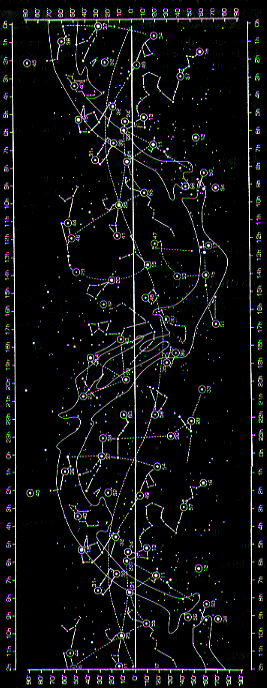


To familiarize students with the use of celestial coordinates to locate objects on a star chart.
Hold up an Earth globe for students to observe. Ask how we describe locations on the globe. Work with student answers to explain the concepts of longitude and latitude.
Explain that the field of stars we look up and out at, also has a globe shape, surrounding the earth, and that astronomers also use coordinates rather like longitude and latitude to locate objects precisely in the sky.
Materials
Procedure Distribute activity sheets and help students identify the coordinates. Right Ascension is like longitude and Declination is like latitude. Use the first set of five stars for practice with students. Ask them to locate the star number (used by the Shuttle astronauts in their celestial navigation round the Earth) and read the coordinates. Check the list to be certain that they have used the coordinates correctly. Then let them complete the rest of the sheet.
Ask students to explain the fact that we can't see all stars all the time from any one location on Earth. Ask them to design a simple overlay that might be placed in front of the chart to simulate this phenomenon. As you can see from the next activity, the answer is a kind of mask which represents the effect of the seasons and the time of day.
Interdisciplinary Connection 
Ask students why the Right Ascension scale is in hours of time instead of degrees. The answer has to do with the historical development of star charts. As the earth turns, the Right Ascension of an object crossing overhead advances by one hour of Right Ascension for each hour that passes. In 24 hours the earth turns once on its axis and the sky goes through 24 hours of Right Ascension.
Note: This "clock" gets off by one day during the year because of the earth's motion around the sun--a fact to share with advanced groups only.
Gerard Manley Hopkins (1844-1889)
Look at the stars! look, look up at the skies!
O look at all the fire-folk sitting in the air!
The bright boroughs, the circle-citadels there!
Down in dim woods the diamond delves! the elves'-eyes!
The grey lawns cold where gold, where quickgold lies!
Wind-beat whitebeam! airy abeles set on a flare!
Flake-doves sent floating forth at a farmyard scare!--
Ah well ! it is all a purchase, all is a prize.
Buy then! bid then!--What?--Prayer, patience, alms, vows.
Look, look: a May-mess, like on orchard boughs!
Look ! March-bloom, like on mealed-with-yellow sallows!
These are indeed the barn; withindoors house
The shocks. This piece-bright paling shuts the spouse
Christ home, Christ and his mother and all his hallows.
This map shows the entire night sky. (Numbered stars are the ones which Shuttle astronauts must find through their star tracker.)
Locations in the sky are much the same as they are on earth, but are given as Declination and Right Ascension, not latitude and longitude. Declination is just like latitude. A star's declination describes its location north or south of the celestial equator. Declination is measured in degrees of arc. A star on the celestial equator has a declination of 0(deg). Positive declinations are in the northern half of the sky. Negative declinations are in the south.
A star's east-west location is called Right Ascension. Right Ascension is measured in hours and minutes of time. The Right Ascension scale runs from 0 hours to 24 hours.

Using the chart, check locations of these well-known stars.
| Star | # | R.A. | Dec. |
| Rigel | 13 | 5.2 hrs. | -8(deg).2 |
| Vega | 14 | 18.6 hrs. | 38(deg).8 |
| Capella | 18 | 5.2 hrs. | 46(deg).0 |
| Antares | 30 | 16.5 hrs. | -26(deg).4 |
| Castor | 31 | 7.5 hrs. | 32(deg).0 |
Locate each of these stars by its coordinates.
Then give its Shuttle ID number
| Star | # | R.A | .Dec. |
| Aldebaran | ......... | 4.6 hrs. | 16(deg).4 |
| Fomalhaut | ......... | 22.9 hrs. | -29(deg).8 |
| Procyon | ......... | 7.6 hrs. | 5(deg).3 |
| Regulus | ......... | 10.1 hrs. | 12(deg).1 |
| Deneb | ......... | 20.7 hrs. | 45(deg).2 |
Locate each of these stars by its Shuttle ID number.
Then give its coordinates.
| Star | # | R.A. | Dec. |
| Altair | 22 | ........... | .......... |
| Betelgeuse | 23 | ........... | .......... |
| Arcturus | 20 | ........... | .......... |
| Spica | 19 | ........... | .......... |
| Sirius | 11 | ........... | .......... |
KAO Connection
Throughout the live broadcasts from the KAO, references will be
made to the Right Ascension and to Declination in respect of targeting
the telescope. It will be helpful for students to become comfortable
with these terms. On-camera Student Challenges will be posed during
the broadcasts, allowing those who've mastered some of the astronomers'
most basic tools to answer correctly!
![]()